
Original Link: https://www.anandtech.com/show/2638
ASUS Rampage II Extreme - First Look
by Gary Key on October 9, 2008 12:00 PM EST- Posted in
- Motherboards
We have received numerous emails about the upcoming X58 motherboards concerning price, availability, and of course performance. Pricing has yet to be determined as we believe each of the manufacturers are waiting to hear what their competitors will charge for a board before committing to a price. What we do know is that the $185 price target mentioned for several X58 motherboards back at Computex has quickly turned into an exclusive $250 and up club from all indications.
Retail availability and launch date is another question that we cannot answer, we know the answer, it's just that our hands (and mouths) are tied by an NDA. All we can say it that it will be soon, but soon for some is tomorrow and for others it could be a month for now. Let's just say they will be out sometime this quarter.
Performance is another subject that we cannot discuss either. The reason is the same as above. Starting to see a pattern develop here? That's what an NDA will do for you. At least we can say this without having the legal eagles from the blue team sweep down upon us; the board we are showing today is the fastest one in the labs to date. It will also probably be the most expensive one, but hey, if you have to ask for the price then you probably can't afford it anyway.
That board is the ASUS Rampage II Extreme featuring the soon to be released X58 chipset supporting an i7 processor. Designed for a very niche market and with limited production numbers, this board will be ASUS' primary weapon in the ultra high-end market against some stiff competition from Gigabyte and perhaps others. The Rampage "2 the" Extreme board is the latest and greatest contribution from the Republic of Gamers (ROG) design group.
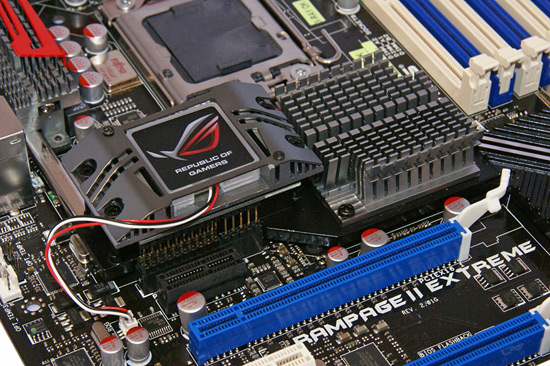
How fast? Imagine a cheetah sprinting for a gazelle after devouring a case of Red Bull. Actually, that has more to do with the 3.2GHz i7 overclocked to a healthy X.XGHz (Ed: Sorry, not yet!) with a few gigabytes of Qimonda's finest running at a leisurely 2200MHz. Yeah, we broke the 1.65V memory guideline, but there is a trick to it without causing permanent damage to the CPU, although our benchmark programs are crying foul right now. To be honest, this board does bring out the best in the new i7 in a very easy manner once you learn the tricks of the BIOS.
While we wanted to show the BIOS options today, ASUS is still discussing it internally. We will provide a gallery update once we get permission. For those of you weaned on overclocking the Core 2 series via the FSB design, get ready for the shock of your life. Those with experience overclocking the Athlon 64 and now Phenom processor series will feel right at home - just start substituting HT with QPI. It is a little more complicated than that actually, as a few of Intel's new features require some additional study. The other problem we have noticed is each of the motherboard suppliers like to name various BIOS options differently, resulting in a need to have five or six BIOS guides ready for the launch on 1X/XX/2008 (Ed: Not going to get away with it).
All that said, let's take a quick look at the ASUS Rampage II Extreme and see what makes this board tick.
The Board
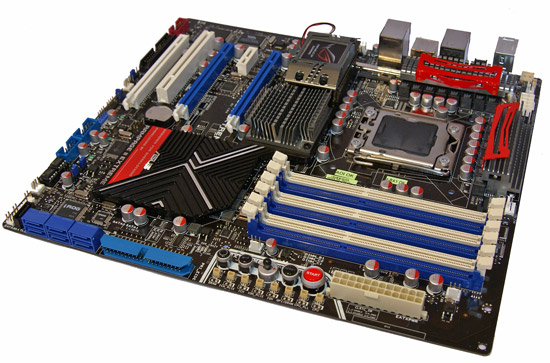
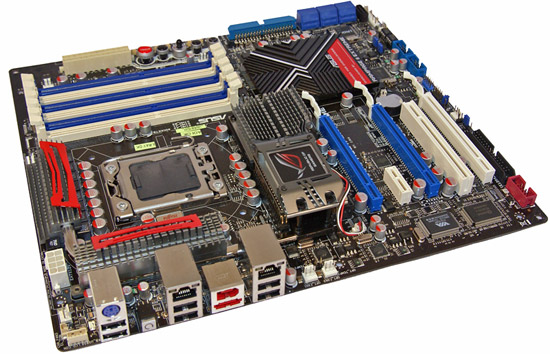
The apple did not fall far from the tree when comparing this latest ROG design to the previous Maximus Formula II and Rampage Extreme boards. We have the return of an eight-layer board dressed out in our favorite black, silver, and Ferrari red color scheme. The memory and peripheral slots return in a blue and white motif with the first PCI Express x1 slot that usually houses the SupremeFX X-FI audio card sporting black.
Due to the new LGA 1333 (Socket B1) design being larger than the current LGA 775, along with six DIMM slots, the area around the CPU is crowded. This results in a creative layout that manages to squeeze all the options into a slightly extended ATX format. However, the layout just does not look as clean as previous ROG offerings to us, even though it is still aesthetically pleasing. We do think ASUS should have dropped the floppy connector; in fact, except for certain business environments, we think it is time to kill the floppy. ASUS throws in seven fan headers that can be controlled and monitored in the BIOS or via a Windows utility program.
ASUS will either include the current LCD Poster that displays system information during POST along with voltage, temperature, or fan speed data. We hope they include the new OC Palm system on the P6T boards that features a full color 320x240 pixel LCD screen that offers the same monitoring features of the LCD Poster or overclocking on the fly controls that are easier to use than the toggle switches.
Around the Rectangle
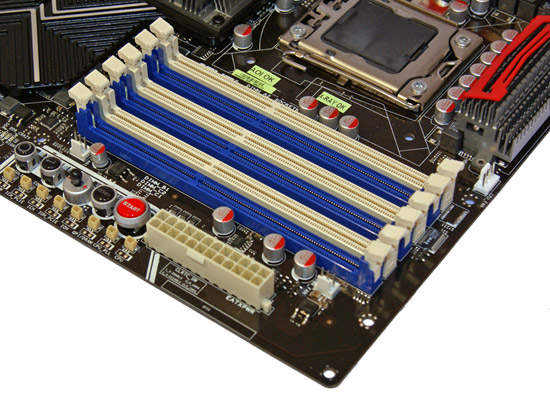
Six DDR3 DIMM slots are included for tri-channel goodness. Performance and compatibility is currently better when utilizing the blue slots. The memory subsystem receives a three-phase power delivery system.
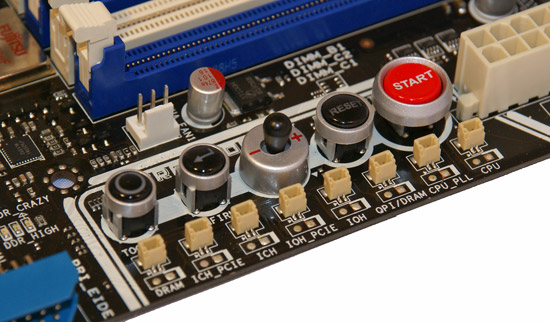
The TweakIT toggle and power/reset switches carry over from the Rampage Extreme board. This system lets you overclock on the fly from within Windows or even during applications when the CPU is loaded. Eight different solder points and pin-outs allow multimeter readings of DIMM, ICH, ICH PCIe, IOH, QPI, CPU PLL, and Core voltages.
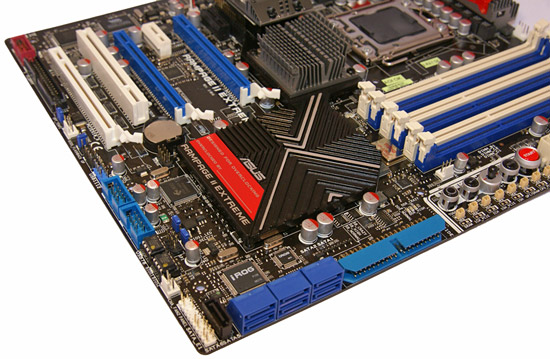
The ICH10R Southbridge is utilized and provides the six SATA ports (dark blue) along with RAID 0, 1, 5, and 10. For some odd reason ASUS reverted to the JMicron JMB363 for an extra SATA port (black), an eSATA port on the IO panel, and IDE duties. We prefer the Marvell or ITE controllers for compatibility and performance reasons. The iROG chipset returns and offers the same features as before: on-board LED control, time keep function, BIOS flashback, additional voltage controls, and a temperature based protection scheme if you enable it.
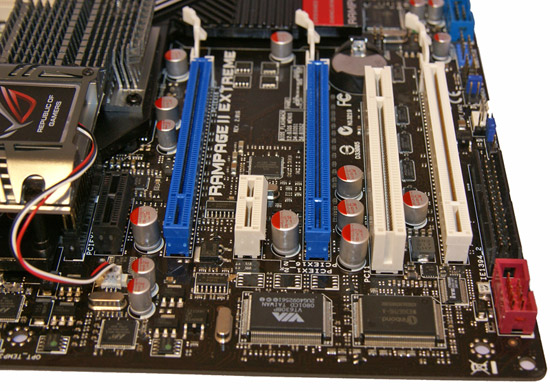
ASUS includes two PCI Express x1 slots, three x16 PCIe 2.0 slots (dual x16 or x16/x8/x8), and a lonely PCI slot. CrossFire and SLI support will be included, but we do not know if Tri-SLI will make an appearance or not. If you utilize double slot GPU cards, the second PCIe x1 slot and the PCI slot will be physically unavailable with a CF or SLI setup.
The black PCIe x1 slot doubles as the HD Audio slot that features the ADI SoundMAX 2000a chipset with support for Creative X-Fi 4.0 routines via a software implementation. This is the last hurrah for the ADI chipset as they have exited the on-board audio business, but they will continue to provide support into the near future. This is good news for Realtek and bad news for users wanting a fairly decent and "free" on-board audio solution.
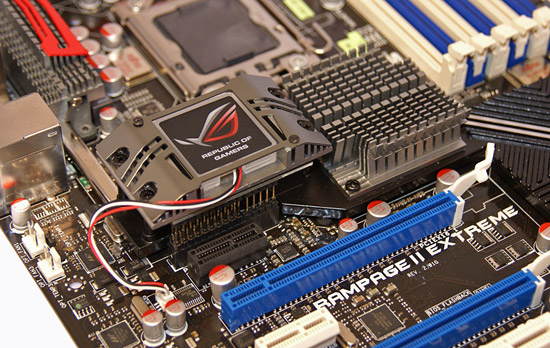
Below the ROG silkscreen (backlighted for your viewing pleasure) is the VTT CPU Power Card that we will investigate further in the full article. The second heatsink is for the X58 chipset and works quite well in early testing. However, if you are running a CF or SLI setup and need the first PCIe x1 slot for audio or other purposes, you are out of luck as the last set of fins on the heatsink blocks full-length cards. We hope that ASUS will address this before commencing retail production.
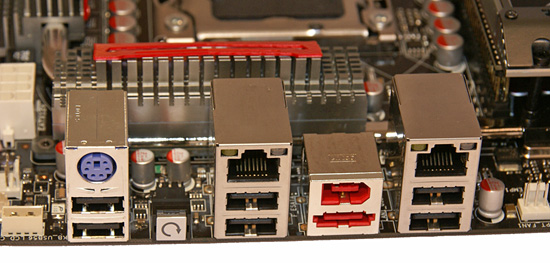
The IO panel is a standard design and almost legacy free. The PS/2 keyboard port is a nod to the overclocking crowd as is the clear CMOS switch. Six USB 2.0 port are available along with six more via headers on the motherboard. An IEEE 1394a port courtesy of the very fast VIA VT8309P chipset and the eSATA port via JMicron's JMB363 are included along with dual RJ-45 ports sporting the Marvell 88E8056-NNC1 controller chips that offer teaming capability.
More Stuff
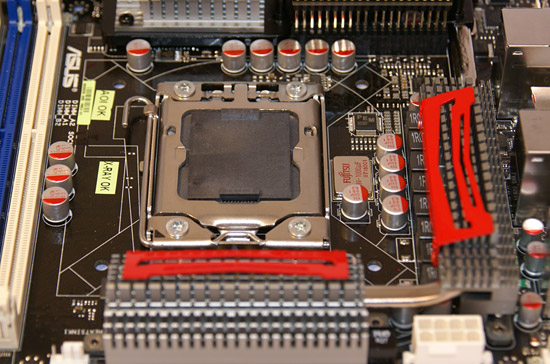
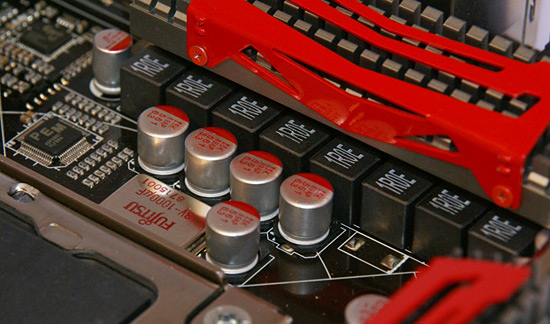
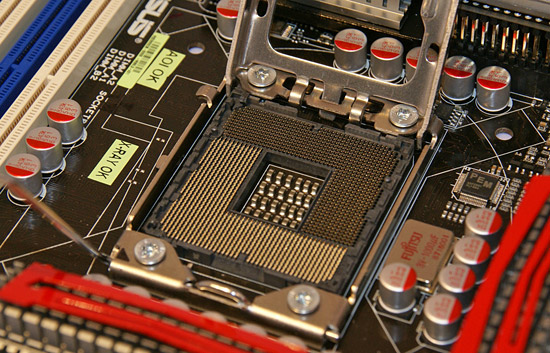
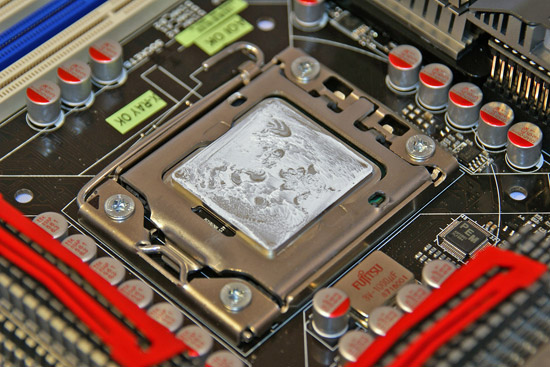
The CPU socket area is crowded but manageable for most cooling setups. ASUS utilizes their "16-phase" power delivery system along with a 3-phase system for the Northbridge. The EPU2 design allows switching between four or sixteen phase to save energy, although we think anyone planning to use this board probably isn't concerned with that feature. The board utilizes a combination of Fujitsu ML and Solid Aluminum capacitors; whether that is a good or bad thing will depend upon how much you push the board.

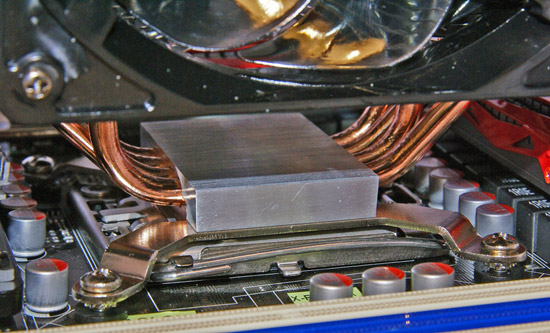
Speaking of cooling, the new LGA 1366 requires new mounting points, and this is going to be good news for the cooling companies as it opens up a new market. After speaking with companies ranging from Cooler Master to Thermalright, the majority of LGA 1366 cooling designs will be based on current LGA 775/AM2 products with the inclusion of new mounting kits. There will be new designs of course as the IHS is larger, but it appears that the cooling companies will release a new mounting kit for current favorite coolers and that the current designs are capable of keeping the i7 cool under most conditions.
Our first revised cooler in the labs is from Vigor Gaming. The Monsoon III LT features support for LGA 775, LGA 1366, LGA 771 Skulltrail, S754, S939, and AM2/AM2+ formats. The unit features two 120x120x25mm fans rated at 20 dBA idle with PWM control. Fan speed is adjustable from 800RPM~2000RPM. The unit measures 131x120.9x160mm with a weight of 855g. We cannot mention results yet, but they are certainly promising with the i7-965 overclocked.
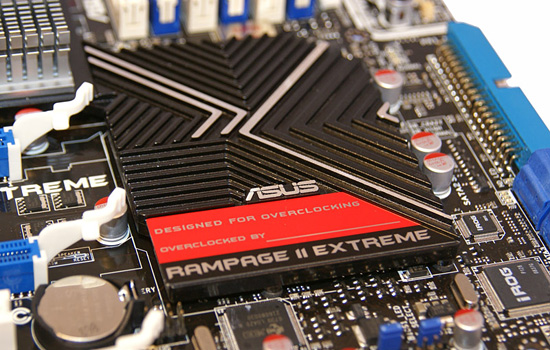
That concludes our first look at the ASUS Rampage II Extreme board. We will be back later with previews of boards from a variety of manufacturers.













